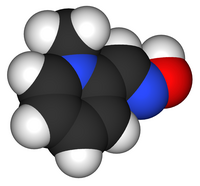Pralidoxime
This article needs additional citations for verification. (June 2010) |
 | |
 | |
| Clinical data | |
|---|---|
| Other names | 1-methylpyridine-6-carbaldehyde oxime |
| AHFS/Drugs.com | Micromedex Detailed Consumer Information |
| Pregnancy category |
|
| ATC code | |
| Legal status | |
| Legal status |
|
| Identifiers | |
| |
| CAS Number | |
| PubChem CID | |
| DrugBank | |
| ChemSpider | |
| UNII | |
| KEGG | |
| ChEBI | |
| ChEMBL | |
| CompTox Dashboard (EPA) | |
| ECHA InfoCard | 100.027.080 |
| Chemical and physical data | |
| Formula | C7H9N2O+ |
| Molar mass | 137.159 g/mol g·mol−1 |
| 3D model (JSmol) | |
| |
| |
| (verify) | |
Pralidoxime (2-pyridine aldoxime methyl chloride,) or 2-PAM, usually as the chloride or methiodide salts, belongs to a family of compounds called oximes that bind to organophosphate-inactivated acetylcholinesterase. It is used to combat poisoning by organophosphates[1] or acetylcholinesterase inhibitors (nerve agents) in conjunction with atropine and diazepam.
Mechanism of action
Pralidoxime is typically used in cases of organophosphate poisoning. The acetylcholinesterase enzyme has two parts to it. An acetylcholine molecule, bound at both ends to both sites of the enzyme, is cleaved in two to form acetic acid and choline. In organophosphate poisoning, an organophosphate binds to just one end of the acetylcholinesterase enzyme (the esteric site), blocking its activity. Pralidoxime is able to attach to the other half (the unblocked, anionic site) of the acetylcholinesterase enzyme. It then binds to the organophosphate, the organophosphate changes conformation, and loses its binding to the acetylcholinesterase enzyme. The conjoined poison / antidote then unbinds from the site, and thus regenerates the enzyme, which is now able to function again.
After some time though, some inhibitors can develop a permanent bond with cholinesterase, known as aging, where oximes such as pralidoxime cannot reverse the bond. Pralidoxime is often used with atropine (a muscarinic antagonist) to help reduce the parasympathetic effects of organophosphate poisoning. Pralidoxime is only effective in organophosphate toxicity (i.e. it does not have an effect if the acetylcholinesterase enzyme is carbamylated, as occurs with neostigmine or physostigmine).
Pralidoxime has an important role in reversing paralysis of the respiratory muscles but due to its poor blood–brain barrier penetration, it has little effect on centrally-mediated respiratory depression. This is why atropine, which has excellent blood–brain barrier penetration, is concomitantly administered with pralidoxime during the treatment of organophosphate poisoning. While the efficacy of atropine has been well-established, clinical experience with pralidoxime has led to widespread doubt about its efficacy in treatment of Organophosphorus poisoning.[2]
Dosage
- Adults: 30 mg/kg (typically 1-2 g), administered by intravenous therapy over 15–30 minutes or intramuscular injection or subcutaneous injection, repeated 60 minutes later. It can also be given as a 500 mg/h continuous IV infusion.
- Children: 20–50 mg/kg followed by a maintenance infusion at 5–10 mg/kg/h.
Intravenous infusions can lead to respiratory or cardiac arrest if given too quickly.[3]
Interactions
When atropine and pralidoxime are used together, the signs of atropinization (flushing, mydriasis, tachycardia, dryness of the mouth and nose) may occur earlier than might be expected when atropine is used alone. This is especially true if the total dose of atropine has been large and the administration of pralidoxime has been delayed.
The following precautions should be kept in mind in the treatment of anticholinesterase poisoning, although they do not bear directly on the use of pralidoxime: since barbiturates are potentiated by the anticholinesterases, they should be used cautiously in the treatment of convulsions; morphine, theophylline, aminophylline, succinylcholine, reserpine, and phenothiazine-type tranquilizers should be avoided in patients with organophosphate poisoning.
Contraindications
There are no known absolute contraindications for the use of pralidoxime. Relative contraindications include known hypersensitivity to the drug and other situations in which the risk of its use clearly outweighs possible benefit.
Chemical synthesis
Pralidoxime, 2-pyridinaldoxime methylchloride, is synthesized by reacting picolinaldehyde (2-formyl pyridine) with hydroxylamine, giving pyridine-2-aldoxime, which is further reacted with methyl iodide, giving the desired pralidoxime.[4][5][6][7]

See also
References
- ^ Jokanović M, Prostran M (2009). "Pyridinium oximes as cholinesterase reactivators. Structure-activity relationship and efficacy in the treatment of poisoning with organophosphorus compounds". Curr. Med. Chem. 16 (17): 2177–88. doi:10.2174/092986709788612729. PMID 19519385.
- ^ [2]Banerjee I, Tripathi S K, Roy A S. Efficacy of pralidoxime in organophosphorus poisoning: Revisiting the controversy in Indian setting. J Postgrad Med 2014;60:27-30
- ^ Baxter Healthcare Corporation 2006, Protopam Prescribing Information
- ^ D. Nachmansonn, S. Ginsburg, U.S. patent 2,816,113 (1957)
- ^ L.P. Black, U.S. patent 3,123,613 (1964)
- ^ D.E. Easterday, A.A. Kondritzer, U.S. patent 3,140,289 (1964)
- ^ W.B. McDowell, U.S. patent 3,155,674 (1964)
